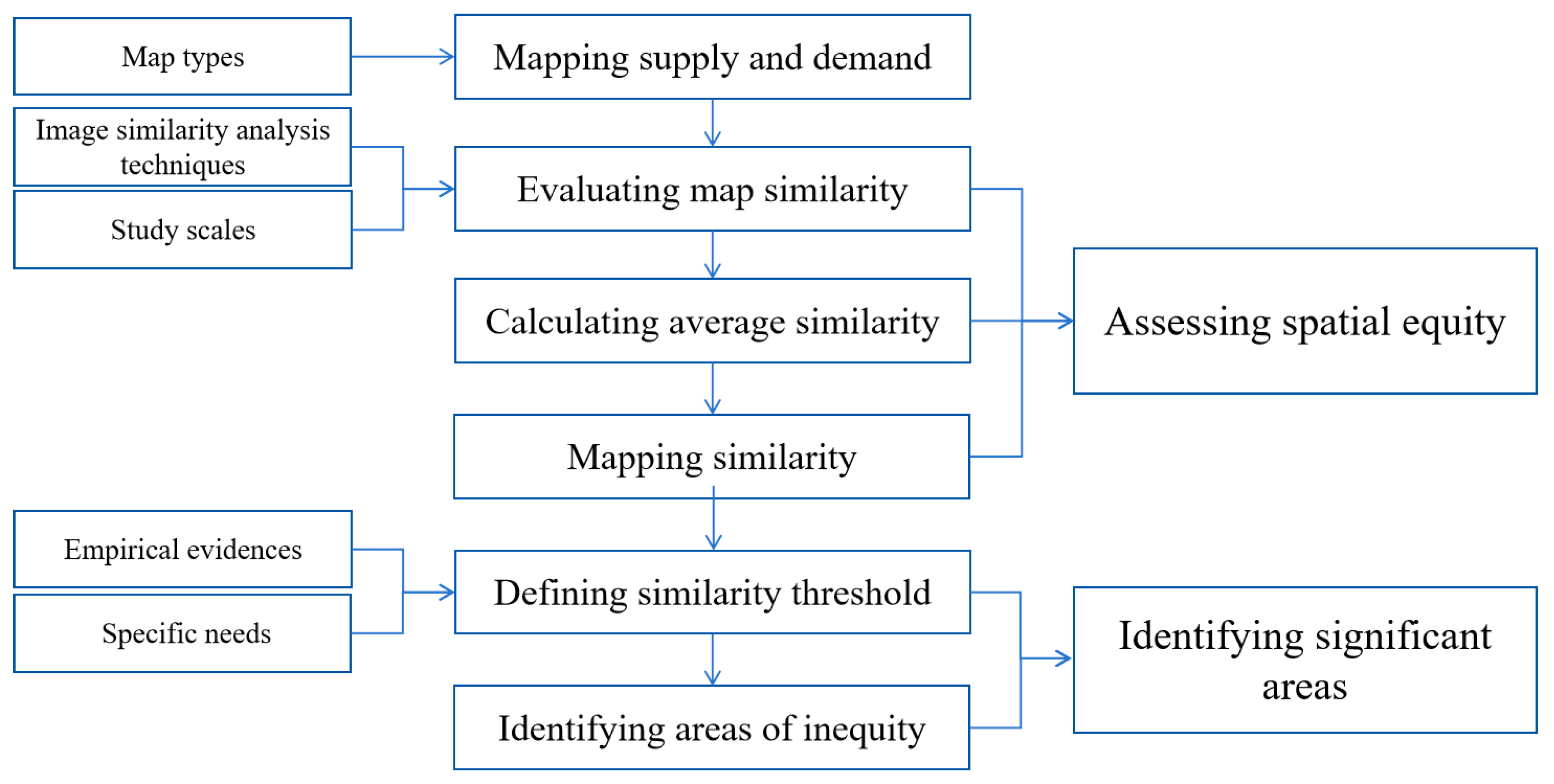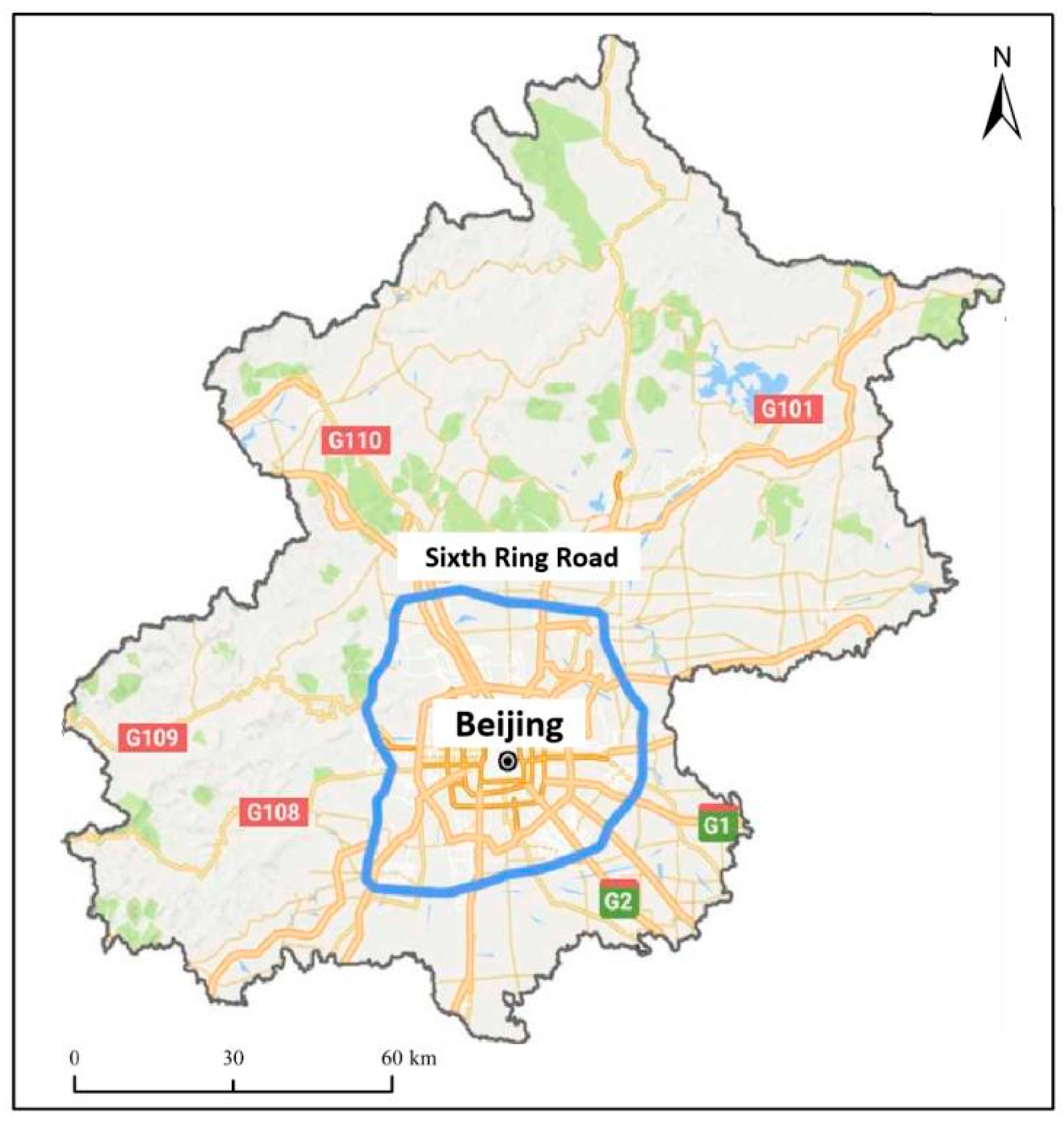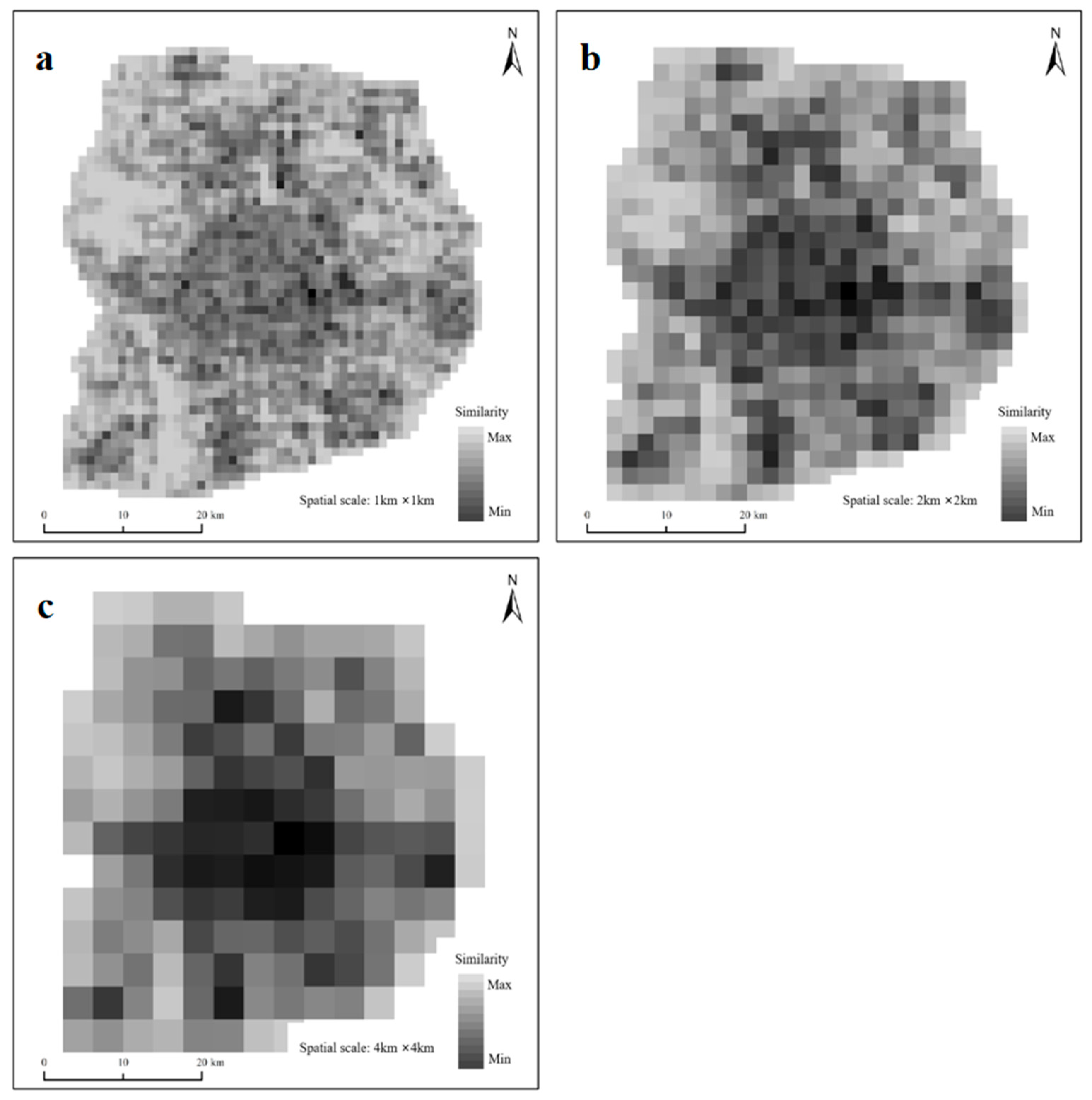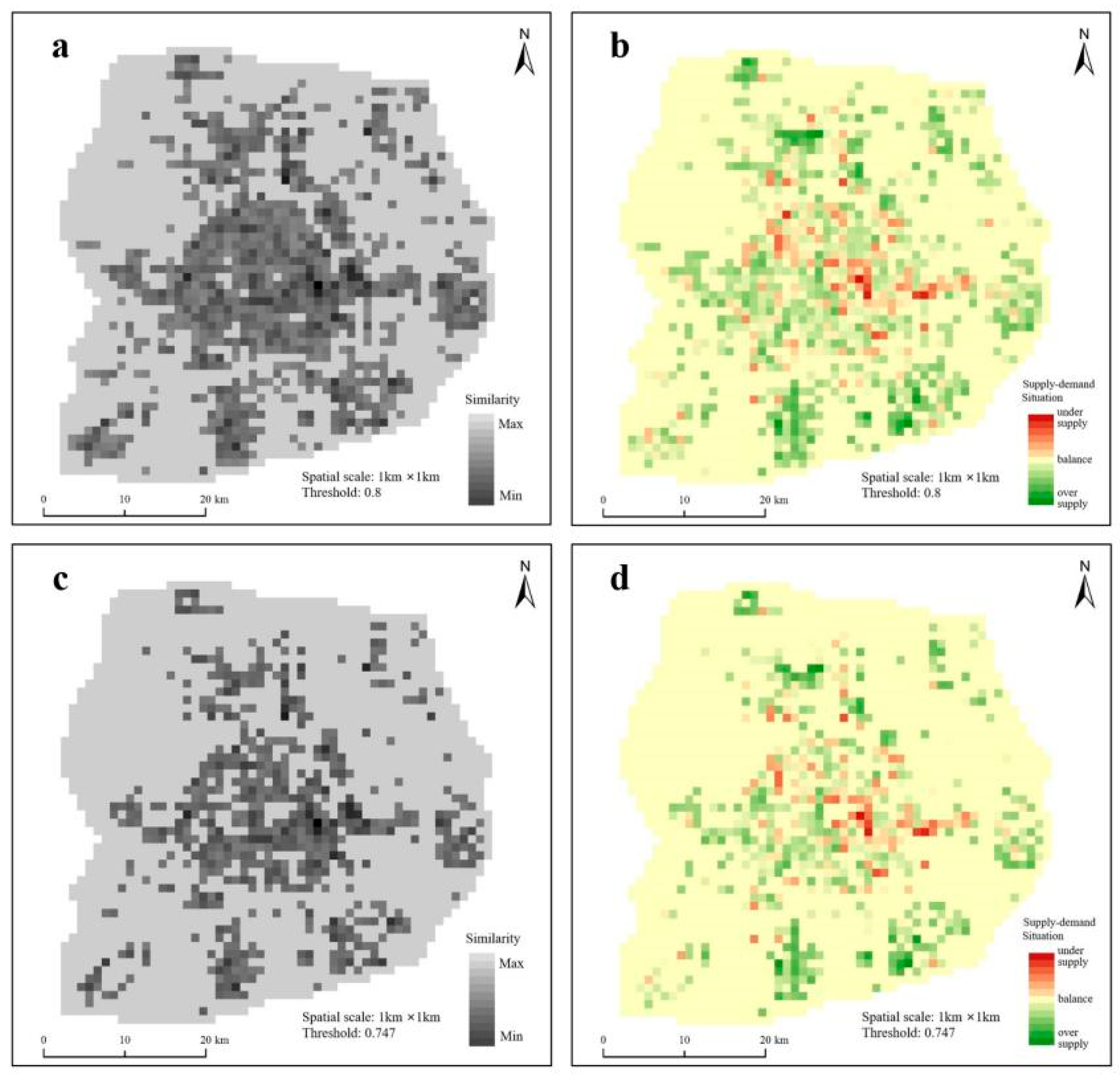Assess Spatial Equity Considering the Similarity Between GIS-Based Supply and Demand Maps: A New Framework with Case Study in Beijing
Abstract
1. Introduction
2. Methods
2.1. Map Similarity as a Measure of Spatial Equity
2.2. Procedure for Spatial Equity Assessment
2.3. Depicting Spatial Distribution and Strength: Extended Kernel Density Estimator
2.4. Evaluating Map Similarity: SSIM Index
3. Case Study
3.1. Study Area and Data Source
3.2. Implementation of the Proposed Framework
4. Result and Discussion
4.1. Mapping Supply and Demand
4.2. Assessing Spatial Equity
4.3. Identifying Significant Areas
4.4. Implications and Recommendations from the Case
4.5. Application Prospects of the Proposed Framework
5. Conclusions
Author Contributions
Funding
Data Availability Statement
Acknowledgments
Conflicts of Interest
References
- Alonso, W. Equity and its relation to efficiency in urbanization. In Essays in Regional Economics; Harvard University Press: Cambridge, MA, USA, 1971; pp. 40–57. [Google Scholar]
- Deutsch, M. Equity, equality, and need: What determines which value will be used as the basis of distributive justice? J. Soc. Issues 1975, 31, 137–149. [Google Scholar]
- Omer, I. Evaluating accessibility using house-level data: A spatial equity perspective. Comput. Environ. Urban Syst. 2006, 30, 254–274. [Google Scholar]
- Taleai, M.; Sliuzas, R.; Flacke, J. An integrated framework to evaluate the equity of urban public facilities using spatial multi-criteria analysis. Cities 2014, 40, 56–69. [Google Scholar] [CrossRef]
- Stone, D.A. Policy Paradox: The Art of Political Decision Making; WW Norton & Company: New York, NY, USA, 2022. [Google Scholar]
- Lucy, W. Equity and planning for local services. J. Am. Plan. Assoc. 1981, 47, 447–457. [Google Scholar]
- Talen, E. The social goals of new urbanism. Hous. Policy Debate 2002, 13, 165–188. [Google Scholar]
- Tsou, K.W.; Hung, Y.T.; Chang, Y.L. An accessibility-based integrated measure of relative spatial equity in urban public facilities. Cities 2005, 22, 424–435. [Google Scholar]
- Qin, X.; Wei, Y.D.; Wu, Y.; Huang, X. Regional development and inequality within city regions: A study of the Yangtze River delta, China. Geogr. Rev. 2023, 113, 359–385. [Google Scholar]
- Wang, Z.; Wang, T.; Zang, L.; Wang, L.; Zhang, Y. Spatial Equity Disparities of Work Commuting Based on Job Accessibility in Chengdu, China. ISPRS Int. J. Geo-Inf. 2024, 13, 417. [Google Scholar] [CrossRef]
- Zhao, Y.; Zhou, Y. Isochrone-Based Accessibility Analysis of Pre-Hospital Emergency Medical Facilities: A Case Study of Central Districts of Beijing. ISPRS Int. J. Geo-Inf. 2024, 13, 288. [Google Scholar] [CrossRef]
- Peters, P.E. Inequality and social conflict over land in Africa. J. Agrar. Change 2004, 4, 269–314. [Google Scholar]
- Oviedo, D. Making the links between accessibility, social and spatial inequality, and social exclusion: A framework for cities in Latin America. Adv. Transp. Policy Plan. 2021, 8, 135–172. [Google Scholar]
- Boyce, J.K. Inequality as a cause of environmental degradation. Ecol. Econ. 1994, 11, 169–178. [Google Scholar] [CrossRef]
- Bjørnskov, C.; Dreher, A.; Fischer, J.A.; Schnellenbach, J.; Gehring, K. Inequality and happiness: When perceived social mobility and economic reality do not match. J. Econ. Behav. Organ. 2013, 91, 75–92. [Google Scholar]
- Harmon, T. Integrating Social Equity and Growth Management; Institute for Community Economics: Springfield, MA, USA, 2003. [Google Scholar]
- Yu, P.; Yung, E.H.; Chan, E.H.; Zhang, S.; Wang, S.; Chen, Y. The Spatial Effect of Accessibility to Public Service Facilities on Housing Prices: Highlighting the Housing Equity. ISPRS Int. J. Geo-Inf. 2023, 12, 228. [Google Scholar] [CrossRef]
- Zhang, R.; Peng, S.; Sun, F.; Deng, L.; Che, Y. Assessing the social equity of urban parks: An improved index integrating multiple quality dimensions and service accessibility. Cities 2022, 129, 103839. [Google Scholar]
- Angelidou, M. Smart city policies: A spatial approach. Cities 2014, 41, S3–S11. [Google Scholar] [CrossRef]
- Li, C.; Wang, J. Measuring multi-activities accessibility and equity with accessibility-oriented development strategies. Transp. Res. Part D Transp. Environ. 2024, 126, 104035. [Google Scholar]
- Wilkinson, C.; Saarne, T.; Peterson, G.D.; Colding, J. Strategic spatial planning and the ecosystem services concept–an historical exploration. Ecol. Soc. 2013, 18, 37. [Google Scholar]
- Guo, Y.; Chen, Z.; Stuart, A.; Li, X.; Zhang, Y. A systematic overview of transportation equity in terms of accessibility, traffic emissions, and safety outcomes: From conventional to emerging technologies. Transp. Res. Interdiscip. Perspect. 2020, 4, 100091. [Google Scholar]
- Neutens, T. Accessibility, equity and health care: Review and research directions for transport geographers. J. Transp. Geogr. 2015, 43, 14–27. [Google Scholar]
- Whitehead, J.; Pearson, A.L.; Lawrenson, R.; Atatoa-Carr, P. How can the spatial equity of health services be defined and measured? A systematic review of spatial equity definitions and methods. J. Health Serv. Res. Policy 2019, 24, 270–278. [Google Scholar] [CrossRef] [PubMed]
- Faghihinejad, F.; Zoghifard, M.; Amiri, A.M.; Monajem, S. Evaluating social and spatial equity in public transport: A case study. Transp. Lett. 2023, 15, 1420–1429. [Google Scholar] [CrossRef]
- Guo, S.; Pei, T.; Wang, X.; Song, C.; Chen, X.; Chen, J.; Shu, H.; Liu, Y.; Wu, M. Equity of subway accessibility: A perspective from work commute trips. Transp. Res. Part D Transp. Environ. 2022, 113, 103515. [Google Scholar] [CrossRef]
- Li, Z.; Liang, Z.; Feng, L.; Fan, Z. Beyond accessibility: A multidimensional evaluation of urban park equity in Yangzhou, China. ISPRS Int. J. Geo-Inf. 2022, 11, 429. [Google Scholar] [CrossRef]
- Yang, W.; Cheng, Y.; Xu, C.; Zhang, J. The Seasonal Migrants Spatially Affect the Park Green Space Accessibility and Equity under Different Travel Modes: Evidence from Sanya, China. ISPRS Int. J. Geo-Inf. 2023, 12, 423. [Google Scholar] [CrossRef]
- Sabokbar, H.F.; Mohammadi, H.; Tahmasbi, S.; Rafii, Y.; Hosseini, A. Measuring spatial accessibility and equity to healthcare services using fuzzy inference system. Appl. Geogr. 2021, 136, 102584. [Google Scholar] [CrossRef]
- Jang, S.; An, Y.; Yi, C.; Lee, S. Assessing the spatial equity of Seoul’s public transportation using the Gini coefficient based on its accessibility. Int. J. Urban Sci. 2017, 21, 91–107. [Google Scholar] [CrossRef]
- Mahmut, M.; Yin, P.; Peng, B.; Wu, J.; Wang, T.; Yuan, S.; Zhang, Y. Examining Spatial Accessibility and Equity of Public Hospitals for Older Adults in Songjiang District, Shanghai. ISPRS Int. J. Geo-Inf. 2024, 13, 403. [Google Scholar] [CrossRef]
- Raza, A.; Zhong, M.; Akuh, R.; Safdar, M. Public transport equity with the concept of time-dependent accessibility using Geostatistics methods, Lorenz curves, and Gini coefficients. Case Stud. Transp. Policy 2023, 11, 100956. [Google Scholar] [CrossRef]
- Ansong, D.; Ansong, E.K.; Ampomah, A.O.; Adjabeng, B.K. Factors contributing to spatial inequality in academic achievement in Ghana: Analysis of district-level factors using geographically weighted regression. Appl. Geogr. 2015, 62, 136–146. [Google Scholar] [CrossRef]
- Roy, S.; Majumder, S.; Bose, A.; Chowdhury, I.R. The rich-poor divide: Unravelling the spatial complexities and determinants of wealth inequality in India. Appl. Geogr. 2024, 166, 103267. [Google Scholar]
- Xiao, Y.; Wang, Z.; Li, Z.; Tang, Z. An assessment of urban park access in Shanghai–Implications for the social equity in urban China. Landsc. Urban Plan. 2017, 157, 383–393. [Google Scholar]
- Bergs, R.; Budde, R. The potential of small-scale spatial data in regional science. Rev. Reg. Res. 2022, 42, 97–110. [Google Scholar]
- Dungan, J.L.; Perry, J.N.; Dale, M.R.T.; Legendre, P.; Citron-Pousty, S.; Fortin, M.J.; Jakomulska, A.; Miriti, M.; Rosenberg, M. A balanced view of scale in spatial statistical analysis. Ecography 2002, 25, 626–640. [Google Scholar]
- Oshan, T.M.; Wolf, L.J.; Sachdeva, M.; Bardin, S.; Fotheringham, A.S. A scoping review on the multiplicity of scale in spatial analysis. J. Geogr. Syst. 2022, 24, 293–324. [Google Scholar] [CrossRef]
- Zhang, J.; Tan, P.Y. Assessment of spatial equity of urban park distribution from the perspective of supply-demand interactions. Urban For. Urban Green. 2023, 80, 127827. [Google Scholar] [CrossRef]
- Hou, W.; Li, X. Assessing urban green infrastructure: A simple and practical measure of its spatial distribution equity and a comprehensive evaluation. Ecol. Indic. 2024, 158, 111408. [Google Scholar]
- Sari Aslam, N.; Ibrahim, M.R.; Cheng, T.; Chen, H.; Zhang, Y. ActivityNET: Neural networks to predict public transport trip purposes from individual smart card data and POIs. Geo-Spat. Inf. Sci. 2021, 24, 711–721. [Google Scholar] [CrossRef]
- Wang, Z.; Ito, K.; Biljecki, F. Assessing the equity and evolution of urban visual perceptual quality with time series street view imagery. Cities 2024, 145, 104704. [Google Scholar] [CrossRef]
- Weigand, M.; Wurm, M.; Dech, S.; Taubenböck, H. Remote sensing in environmental justice research—A review. ISPRS Int. J. Geo-Inf. 2019, 8, 20. [Google Scholar] [CrossRef]
- Yang, G.; Zhao, Y.; Xing, H.; Fu, Y.; Liu, G.; Kang, X.; Mai, X. Understanding the changes in spatial fairness of urban greenery using time-series remote sensing images: A case study of Guangdong-Hong Kong-Macao Greater Bay. Sci. Total Environ. 2020, 715, 136763. [Google Scholar] [CrossRef] [PubMed]
- Xu, C.; Chen, G.; Huang, Q.; Su, M.; Rong, Q.; Yue, W.; Haase, D. Can improving the spatial equity of urban green space mitigate the effect of urban heat islands? An empirical study. Sci. Total Environ. 2022, 841, 156687. [Google Scholar] [CrossRef] [PubMed]
- Okarma, K. Combined image similarity index. Opt. Rev. 2012, 19, 349–354. [Google Scholar] [CrossRef]
- Zhang, L.; Zhang, L.; Mou, X.; Zhang, D. FSIM: A feature similarity index for image quality assessment. IEEE Trans. Image Process. 2011, 20, 2378–2386. [Google Scholar]
- Mouter, N.; van Cranenburgh, S.; van Wee, B. An empirical assessment of Dutch citizens’ preferences for spatial equality in the context of a national transport investment plan. J. Transp. Geogr. 2017, 60, 217–230. [Google Scholar] [CrossRef]
- Rahman, M.; Neema, M.N. A GIS based integrated approach to measure the spatial equity of community facilities of Bangladesh. Aims Geosci. 2015, 1, 21–40. [Google Scholar] [CrossRef]
- Zhao, M.; Liu, S.; Qi, W. Spatial differentiation and influencing mechanism of medical care accessibility in Beijing: A migrant equality perspective. Chin. Geogr. Sci. 2018, 28, 353–362. [Google Scholar] [CrossRef]
- Angus, A.; Burgess, P.J.; Morris, J.; Lingard, J. Agriculture and land use: Demand for and supply of agricultural commodities, characteristics of the farming and food industries, and implications for land use in the UK. Land Use Policy 2009, 26, S230–S242. [Google Scholar] [CrossRef]
- Ding, M.; Song, Y.; Hu, Y. Supply–Demand Matching of Smart Parcel Lockers in a Residential Area: Insights from Tianjin. Buildings 2023, 13, 2088. [Google Scholar] [CrossRef]
- González-García, A.; Palomo, I.; González, J.A.; López, C.A.; Montes, C. Quantifying spatial supply-demand mismatches in ecosystem services provides insights for land-use planning. Land Use Policy 2020, 94, 104493. [Google Scholar] [CrossRef]
- Parzen, E. On estimation of a probability density function and mode. Ann. Math. Stat. 1962, 33, 1065–1076. [Google Scholar]
- Rosenblatt, M. Remarks on some nonparametric estimates of a density function. Ann. Math. Stat. 1956, 27, 832–837. [Google Scholar]
- Bailey, T.C.; Gatrell, A.C. Interactive Spatial Data Analysis; Longman Scientific: Harlow, UK, 1995. [Google Scholar]
- Schabenberger, O.; Gotway, C.A. Statistical Methods for Spatial Data Analysis; Chapman Hall/CRC: Boca Raton, FL, USA, 2005. [Google Scholar]
- Silverman, B.W. Density Estimation for Statistics and Data Analysis; Chapman Hall: London, UK, 1986. [Google Scholar]
- Deaton, A. The Analysis of Household Surveys: A Microeconometric Approach to Development Policy; World Bank Publications: Washington, DC, USA, 1997. [Google Scholar]
- Gisbert, F.J.G. Weighted samples, kernel density estimators and convergence. Empir. Econ. 2003, 28, 335–351. [Google Scholar] [CrossRef]
- Patil, G.P.; Rao, C.R.; Zelen, M.; Patil, G.P. Weighted Distributions. Center for Statistical Ecology and Environmental Statistics; Pennsylvania State University: University Park, PA, USA, 1987. [Google Scholar]
- Wang, Z.; Bovik, A.C. A universal image quality index. IEEE Signal Process. Lett. 2002, 9, 81–84. [Google Scholar] [CrossRef]
- Wang, Z.; Bovik, A.C.; Sheikh, H.R.; Simoncelli, E.P. Image quality assessment: From error visibility to structural similarity. IEEE Trans. Image Process. 2004, 13, 600–612. [Google Scholar]
- Sun, C.; Zheng, S.; Wang, R. Restricting driving for better traffic and clearer skies: Did it work in Beijing? Transp. Policy 2014, 32, 34–41. [Google Scholar]
- Zheng, Y.; Moody, J.; Wang, S.; Zhao, J. Measuring policy leakage of Beijing’s car ownership restriction. Transp. Res. Part A Policy Pract. 2021, 148, 223–236. [Google Scholar]
- Shi, J.; Wu, Z.; Jin, J. Reform Beijing to a public transit oriented city–from the view of transportation equity. J. Adv. Transp. 2011, 45, 96–106. [Google Scholar]
- Cuthill, N.; Cao, M.; Liu, Y.; Gao, X.; Zhang, Y. The association between urban public transport infrastructure and social equity and spatial accessibility within the urban environment: An investigation of Tramlink in London. Sustainability 2019, 11, 1229. [Google Scholar] [CrossRef]
- Wang, J.; Deng, Y.; Song, C.; Tian, D. Measuring time accessibility and its spatial characteristics in the urban areas of Beijing. J. Geogr. Sci. 2016, 26, 1754–1768. [Google Scholar]
- Zhang, C.; Xia, H.; Song, Y. Rail transportation lead urban form change: A case study of Beijing. Urban Rail Transit 2017, 3, 15–22. [Google Scholar] [CrossRef]
- Beijing Municipal Bureau of Statistics. Beijing Statistical Yearbook 2023; China Statistics Press: Beijing, China, 2023. [Google Scholar]
- Coskun, B.; Memon, N. Confusion/diffusion capabilities of some robust hash functions. In Proceedings of the 2006 40th Annual Conference on Information Sciences and Systems, Princeton, NJ, USA, 22–24 March 2006; pp. 1188–1193. [Google Scholar]
- Mudeng, V.; Kim, M.; Choe, S.W. Prospects of structural similarity index for medical image analysis. Appl. Sci. 2022, 12, 3754. [Google Scholar] [CrossRef]
- Rueangsuwan, N.; Jariyapongsgul, N.; Chen, C.C.; Lin, C.S.; Ruengittinun, S.; Chootong, C. Automatic Anomaly Mark Detection on Fabric Production Video by Artificial Intelligence Techniques. In Proceedings of the 2022 IEEE 5th International Conference on Knowledge Innovation and Invention (ICKII), Hualien, Taiwan, 22–24 July 2022; pp. 81–84. [Google Scholar]
- Wu, J.W.; Wu, C.C.; Cen, W.S.; Chao, S.A.; Weng, J.T. Integrated compressed sensing and YOLOv4 for application in image-storage and object-recognition of dashboard camera. In Proceedings of the 2021 Australian & New Zealand Control Conference (ANZCC), Gold Coast, Australia, 25–26 November 2021; pp. 7–11. [Google Scholar]
- Jin, H.; Jin, F.; Zhu, H. Measuring spatial mismatch between public transit services and regular riders: A case study of Beijing. ISPRS Int. J. Geo-Inf. 2019, 8, 186. [Google Scholar] [CrossRef]
- Sun, Z.; Zacharias, J. Transport equity as relative accessibility in a megacity: Beijing. Transp. Policy 2020, 92, 8–19. [Google Scholar] [CrossRef]
- Yang, X.; Niu, F.; Sun, D. Evaluation of urban spatial equality based on accessibility to economic activities: Beijing as a case study. Complexity 2020, 2020, 4560146. [Google Scholar]
- Ibraeva, A.; de Almeida Correia, G.H.; Silva, C.; Antunes, A.P. Transit-oriented development: A review of research achievements and challenges. Transp. Res. Part A Policy Pract. 2020, 132, 110–130. [Google Scholar] [CrossRef]
- Wang, F.; Zheng, Y.; Wu, W.; Wang, D. The travel, equity and wellbeing impacts of transit-oriented development in Global South. Transp. Res. Part D Transp. Environ. 2022, 113, 103512. [Google Scholar] [CrossRef]
- Wang, R.; Wu, W.; Yao, Y.; Tan, W. “Green transit-oriented development”: Exploring the association between TOD and visible green space provision using street view data. J. Environ. Manag. 2023, 344, 118093. [Google Scholar]
- Nie, Y.; Yang, W.; Chen, Z.; Lu, N.; Huang, L.; Huang, H. Public curb parking demand estimation with poi distribution. IEEE Trans. Intell. Transp. Syst. 2021, 23, 4614–4624. [Google Scholar]
- Zhu, B.; Hu, S.; Kaparias, I.; Zhou, W.; Ochieng, W.; Lee, D.H. Revealing the driving factors and mobility patterns of bike-sharing commuting demands for integrated public transport systems. Sustain. Cities Soc. 2024, 104, 105323. [Google Scholar] [CrossRef]
- Zhou, H.; He, S.; Cai, Y.; Wang, M.; Su, S. Social inequalities in neighborhood visual walkability: Using street view imagery and deep learning technologies to facilitate healthy city planning. Sustain. Cities Soc. 2019, 50, 101605. [Google Scholar] [CrossRef]






| Spatial Scale | Items | Mean | Std.dev | Max. | Min. | L.Q. |
|---|---|---|---|---|---|---|
| 1 km × 1 km | Whole study region | 0.836 | 0.117 | 1.000 | 0.369 | 0.747 |
| Inside the Fourth Ring Road | 0.729 | 0.089 | 1.000 | 0.461 | 0.678 | |
| Outside the Fourth Ring Road | 0.846 | 0.114 | 1.000 | 0.369 | 0.759 | |
| 2 km × 2 km | Whole study region | 0.843 | 0.102 | 1.000 | 0.554 | 0.761 |
| Inside the Fourth Ring Road | 0.717 | 0.062 | 0.889 | 0.554 | 0.677 | |
| Outside the Fourth Ring Road | 0.854 | 0.097 | 1.000 | 0.622 | 0.777 | |
| 4 km × 4 km | Whole study region | 0.855 | 0.092 | 1.000 | 0.644 | 0.784 |
| Inside the Fourth Ring Road | 0.738 | 0.046 | 0.815 | 0.696 | 0.707 | |
| Outside the Fourth Ring Road | 0.859 | 0.091 | 1.000 | 0.644 | 0.788 |
Disclaimer/Publisher’s Note: The statements, opinions and data contained in all publications are solely those of the individual author(s) and contributor(s) and not of MDPI and/or the editor(s). MDPI and/or the editor(s) disclaim responsibility for any injury to people or property resulting from any ideas, methods, instructions or products referred to in the content. |
© 2025 by the authors. Published by MDPI on behalf of the International Society for Photogrammetry and Remote Sensing. Licensee MDPI, Basel, Switzerland. This article is an open access article distributed under the terms and conditions of the Creative Commons Attribution (CC BY) license (https://creativecommons.org/licenses/by/4.0/).
Share and Cite
Hao, X.; Hu, X.; Zhang, K.; Chen, Q. Assess Spatial Equity Considering the Similarity Between GIS-Based Supply and Demand Maps: A New Framework with Case Study in Beijing. ISPRS Int. J. Geo-Inf. 2025, 14, 157. https://doi.org/10.3390/ijgi14040157
Hao X, Hu X, Zhang K, Chen Q. Assess Spatial Equity Considering the Similarity Between GIS-Based Supply and Demand Maps: A New Framework with Case Study in Beijing. ISPRS International Journal of Geo-Information. 2025; 14(4):157. https://doi.org/10.3390/ijgi14040157
Chicago/Turabian StyleHao, Xiatong, Xiaojian Hu, Ke Zhang, and Qian Chen. 2025. "Assess Spatial Equity Considering the Similarity Between GIS-Based Supply and Demand Maps: A New Framework with Case Study in Beijing" ISPRS International Journal of Geo-Information 14, no. 4: 157. https://doi.org/10.3390/ijgi14040157
APA StyleHao, X., Hu, X., Zhang, K., & Chen, Q. (2025). Assess Spatial Equity Considering the Similarity Between GIS-Based Supply and Demand Maps: A New Framework with Case Study in Beijing. ISPRS International Journal of Geo-Information, 14(4), 157. https://doi.org/10.3390/ijgi14040157





